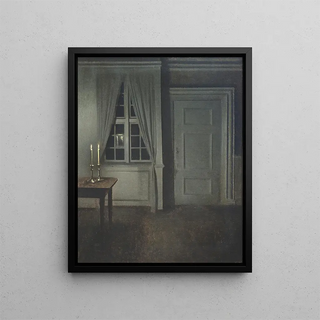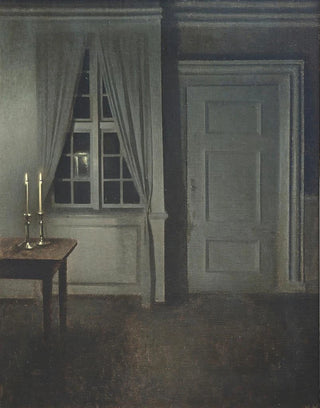Art print | Interior with Two Candles - Vilhelm Hammershøi


View from behind

Frame (optional)
Interior with two candles - Vilhelm Hammershøi – Captivating Introduction
In the mysterious universe of art, some works stand out for their ability to capture the very essence of a fleeting moment. "Interior with two candles" by Vilhelm Hammershøi is one of those pieces that invites contemplation and reflection. In this intimate scene, the soft light of the candles illuminates a simple interior, evoking an atmosphere of calm and melancholy. The apparent simplicity of the composition conceals an emotional depth that resonates with anyone who takes the time to explore the nuances of this artwork. Hammershøi, master of chiaroscuro, manages to transform a simple space into a true tableau of life, where every detail matters and every shadow tells a story.
Style and uniqueness of the work
Hammershøi's style is often associated with the symbolism movement, but his unique approach sets him apart in the early 20th-century artistic landscape. "Interior with two candles" is characterized by a palette of soft colors and streamlined forms, where the absence of human figures only emphasizes the solitude of the space. The candles, sources of light, become focal points that attract the eye and create a dynamic between shadow and clarity. The bare walls and minimalist furniture reflect a Nordic aesthetic, where each element is carefully chosen to contribute to the harmony of the whole. The composition, both simple and complex, provokes reflection on the nature of intimacy and solitude, inviting the viewer to immerse themselves in this silent universe.
The artist and his influence
Vilhelm Hammershøi, born in Copenhagen in 1864, is often regarded as one of Denmark's most important painters of his time. His work, marked by a constant search for light and space, has influenced many contemporary and later artists. Hammershøi draws inspiration from everyday life and landscapes of his homeland, but he manages to transcend the banal to create works of great spiritual depth. His exploration of shadow and light, as well as his ability to evoke complex emotions through seemingly simple scenes, has

Matte finish

View from behind

Frame (optional)
Interior with two candles - Vilhelm Hammershøi – Captivating Introduction
In the mysterious universe of art, some works stand out for their ability to capture the very essence of a fleeting moment. "Interior with two candles" by Vilhelm Hammershøi is one of those pieces that invites contemplation and reflection. In this intimate scene, the soft light of the candles illuminates a simple interior, evoking an atmosphere of calm and melancholy. The apparent simplicity of the composition conceals an emotional depth that resonates with anyone who takes the time to explore the nuances of this artwork. Hammershøi, master of chiaroscuro, manages to transform a simple space into a true tableau of life, where every detail matters and every shadow tells a story.
Style and uniqueness of the work
Hammershøi's style is often associated with the symbolism movement, but his unique approach sets him apart in the early 20th-century artistic landscape. "Interior with two candles" is characterized by a palette of soft colors and streamlined forms, where the absence of human figures only emphasizes the solitude of the space. The candles, sources of light, become focal points that attract the eye and create a dynamic between shadow and clarity. The bare walls and minimalist furniture reflect a Nordic aesthetic, where each element is carefully chosen to contribute to the harmony of the whole. The composition, both simple and complex, provokes reflection on the nature of intimacy and solitude, inviting the viewer to immerse themselves in this silent universe.
The artist and his influence
Vilhelm Hammershøi, born in Copenhagen in 1864, is often regarded as one of Denmark's most important painters of his time. His work, marked by a constant search for light and space, has influenced many contemporary and later artists. Hammershøi draws inspiration from everyday life and landscapes of his homeland, but he manages to transcend the banal to create works of great spiritual depth. His exploration of shadow and light, as well as his ability to evoke complex emotions through seemingly simple scenes, has






